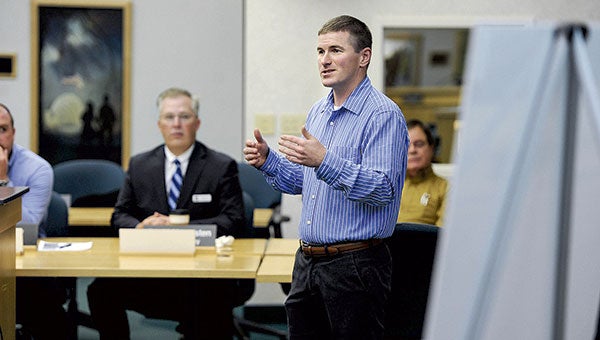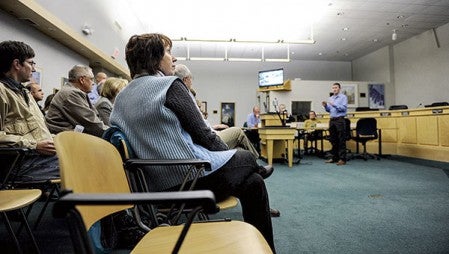Bonding with the state; Austin looking for $7.8M in state bonding money for projects
Published 10:14 am Friday, October 30, 2015

Justin Hanson, Soil and Water Conservation District manager, begins his presentation for members of the Minnesota House Bonding Committee in the City Council chambers Thursday morning. Eric Johnson/photodesk@austindailyherald.com
Austin leaders took a step in their efforts to try to secure $7.8 million in bonding for three bonding projects.
The Minnesota Senate Capital Investment Committee visited Austin as part of a southeast Minnesota tour. Vision 2020, Cedar River Watershed District and city of Austin officials spoke to them about the CRWD’s Accelerated Results Plan and projects to improve recreational capabilities near the Ramsey Dam and Fourth Avenue Northeast Dam. The three proposals would make for a $7.8 million investment in bonding funds if approved.
“All of these projects are really tied together,” Austin Public Works Director Steven Lang said. “Whether it’s the city of Austin or Mower County, we’re really looking for a combination of water quality, flood control and then enhancing those water recreation areas that we have.”
Sen. Dan Sparks, DFL-Austin, a member of the Capital Investment Committee, said they’re going to work hard to try and secure funding in next year’s bonding bill.
“I think it’s important that they spend some time here in Austin to actually look at these projects in person and get a real idea of what we’re trying to do here,” Sparks said.
Ramsey Dam
Vision 2020 and water leaders are looking to make Mower County’s biggest body of water a more utilized asset.
Community leaders are seeking $3 million in state bonding dollars for the Ramsey Dam area and Ramsey Mill Pond near The Old Mill Restaurant to acquire more land, build two miles of trail, restore a railroad bridge, improve the dam and build public amenities to improve the area.
“What we’re trying to do is utilize our biggest body of water here in Austin,” said Tim Ruzek, Vision 2020 Waterways Committee co-chair and Cedar River Watershed District public outreach coordinator
Vision 2020 wants to better utilize Ramsey Mill Pond by acquiring 18 acts of flood-prone land from the dam up to an old railroad bridge, which would be remodeled and become part of a two-mile trail.
“This could be a real destination spot,” Ruzek said.
When showing the committee a map of Mower County, Ruzek noted it showed a lot of brown and little blue, a sign the county doesn’t have an abundant amount of water resources like large lakes, but the county does have several streams and rivers.
“The Water Resources that we do have, are really good; they’re high quality,” Ruzek said. “But people living here, people outside of here, don’t realize how good of a water resource they are.”

Rep. Jeanne Poppe looks up at a slide presentation from Justin Hanson during a visit by the Minnesota Senate Bonding Committee Thursday morning. Eric Johnson/photodesk@austindailyherald.com
Some of the land along the dam is owned by the DNR, but Hanson said many people don’t fully realize that.
“A lot of the public doesn’t even know that that’s available to them,” Ruzek said.
Vision 2020 is working with the DNR to bring a fishing platform to a spot near the dam.
The area was the home of Ramsey Recreation Park in the 1930s, as it was a spot for swimmers, but Ruzek said they don’t encourage swimming today because of water quality concerns.
The area also features an SNA trail that is near the 15 miles of city trails and the nearby Shooting Star Trail, but many people don’t even know that trail is available.
“This has a lot of great potential towards being a great recreational area,” Ruzek said.
Ruzek said there are hundreds of acres of natural land surrounding Ramsey Mill Pond.
“It’s a peaceful, natural looking area,” Ruzek said.
Fourth Avenue Northeast Dam
Leaders are also seeking $600,000 for the Fourth Avenue Northeast Dam area for flood control retaining walls, restoring the old mill site, for stream bank restorations and to study dam conditions.
Overall, the $600,000 project would include restoration of the mill site, stream bank restoration and studies of the conditions of the existing dam.
The plan is to also create a lookout area over the dam on the southeast corner.
That dam was originally a large flour mill, and the city plans to put in some plaques about the historical features of the dam. It was eventually demolished in the 1960s.
“The community built up around the waterways, and we feel it’s important to let everyone know how it developed and why it’s there,” Lang said
The plan would provide more opportunity for use of the dam.
The plan is to create a trailhead and dam portage for the Cedar.
Lang noted the several different partners are all working toward the same goal.
$4.2 million for CRWD’s Accelerated Action Plan
CRWD leaders are seeking $4.2 million for the Accelerated Results Plan, which will complete 25 water retention and water quality projects in the district. The CRWD already has half the money for the $8.4 million project. The district is providing $1.2 million, the Hormel Foundation is providing $3 million, and the district is looking for the state to match those funds.
Cedar River Watershed District Resource Specialist Justin Hanson told the committee that waterways are important to the people and community, which was shown when the public voted waterways as one of its top ideas for Vision 2020. After addressing issues through Austin’s various flood mitigation efforts, which included several flood buyouts and the retention wall along North Main Street, Hanson said it’s important to take the next step.
“We’re taking the next step,” Hanson said. “We’re going up into the watershed and starting to address the root of those problems.”
Hanson explained that while Mower County may look flat, there’s actually significant, gradual slopes. That makes flooding issues unique in the Austin area. Where floodwaters linger in places like the Red River Valley, flood waters in the area traditionally come through and recede quickly due to the grade and geography.
Hanson compared it to a wave — the flood comes through and the force and energy from the water stirs up sediment, dust and pollutants and drops them in streams.
“We get this big wave that comes through town; it’s knocking Austin over on its butt,” Hanson said.
To address those projects, the Accelerated Results Plan to retain water during peak events for about 48 hours. While the project addresses flooding, Hanson said it’ll have a big impact on water quality.
“Our water resources issues are very closely connected,” Hanson said.
The plan is a partnership with Vision 2020 and the CRWD aimed at making a significant difference in a quick amount of time. The CRWD formed with a goal of reducing water flows by 20 percent — a goal he said many people told Hanson would be very difficulty to achieve. Hanson estimated the 25 projects in the Accelerated Results Plan will reduce flows by 8 percent.
“We’re rolling up our sleeves, and we’re getting after those issues,” Hanson said.
Several of those projects target issues on Dobbins Creek, which Hanson says is public enemy number one. For example, water has flooded Interstate 90 near where Dobbins spills into East Side Lake. The idea is that the 25 projects will retain flood water during peak events to help alleviate the problem.
“This project gets at some of these issues,” Hanson said. “We have to get on top of that. It’s our responsibility as a watershed district to address these issues.”
Looking ahead to 2016
To Rep. Jeanne Poppe, DFL-Austin, a key message about the projects on Thursday was that they’re all connected. She noted that water quality and flood mitigation are tied closely together.
“To be able to use the water and the land to the best benefit, that’s an important piece,” Poppe said.
Poppe noted Austin’s water quality and flood efforts are different than those in different areas. The same fixes likely won’t work in two areas, which is why she was excited about the plans Austin is proposing.
“I think it’s a rare and unique opportunity in our area,” Poppe said.
But Sparks and Poppe were both hopeful the Austin projects would get funding.
Sparks referenced bonding dollars for flood mitigation and the Hormel Institute as proof he and Poppe have been successful in securing and using bonding dollars for meaningful projects.
“I’m hopeful that we’ll be successful again this year,” he said.
But Sparks estimated that about one in every four projects gets funding.
“It is highly competitive, but I think we’ve proven that we’ve been good stewards of this money in the past,” Sparks said.
Sparks the local match and money from the Hormel Foundation could help put some of the local projects near the top of the list.
This session is expected to be short, Poppe noted. The Legislature is expected to talk about the projected surplus, whether there will be a tax bill and transportation — including whether bonding dollars will and should be used on transportation. But Poppe said that would bonding dollars much more competitive.
“If you start using bonding dollars for transportation, you are then restricting the opportunity for projects like this or college projects or whatever,” she said.





